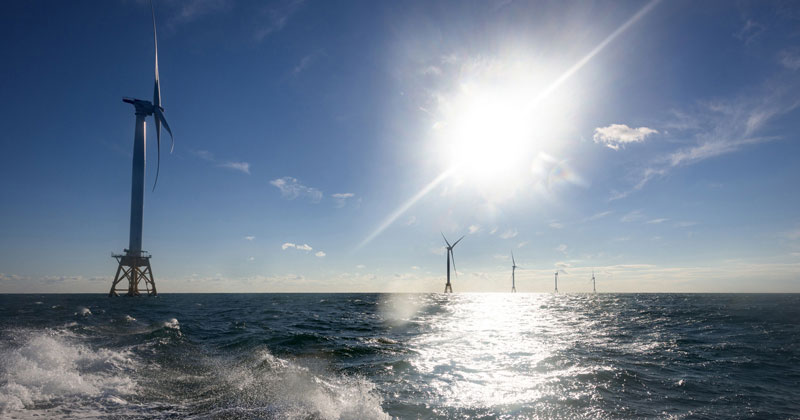


Surface impact of offshore wind turbines
Photo by Evan Krape July 12, 2022
UD study looks to see if offshore wind farms would impact surface weather
As offshore wind projects in the United States get closer to a reality, one question that needs to be answered is how — if at all — these offshore wind farms are going to affect life for those living on the coast.
Of particular concern is if these offshore wind farms will have any impact on the weather, more specifically on surface wind speed and temperature.
A new study from the University of Delaware published in Environmental Research Letters shows that those living on the East Coast shouldn’t worry about any potential meteorological changes to the surface temperature or wind speed as a result of offshore wind farms.
The research showed that during the summer months, the effects on temperature were negligible — even showing a slight cooling at the surface. While wind speed does decrease at the surface within the offshore wind farm areas, the reduction in wind speed doesn’t reach the coastal area and won’t impact the coastal community because the prevailing wind is blowing towards the ocean in the summer.
Maryam Golbazi, who received her doctoral degree from UD in ocean engineering in 2022, was the lead author of the paper. Cristina Archer, director of the Center for Research in Wind (CReW), the Unidel Howard Crosgrove Career Development Chair in the Environment and professor in Geography and Spatial Sciences and Mechanical Engineering, and Stefano Alessandrini, from the National Center for Atmospheric Research, served as co-authors on the paper.

The researchers wanted to get a better understanding of the potential meteorological impacts for coastal communities near offshore wind farms because it’s only a matter of time before these large projects come to the United States.
“These wind farms are going to occupy a big area, hosting more than 2,000 turbines,” said Golbazi. “One question I have been seeing in relation to this is, ‘How are they going to impact meteorology at the surface’ or ‘how are they going to impact the coastal community?’ So we wanted to find a scientific answer to this question for the community.”
To conduct their study, the researchers looked at coastal states along the East Coast such as New Jersey, New York, Maryland, Rhode Island, Delaware, Massachusetts and Connecticut. Because temperature changes caused by wind farms appear to be the strongest during stable atmospheric conditions — and those stable conditions occur mostly during the summer — the researchers based their study on simulations of the summer of 2018.
No large offshore wind farms have been installed yet in the United States, so the researchers had to use a modeling approach to look at their potential impact. They used the Weather Research and Forecasting (WRF) model, which is used for forecasting purposes in real-time simulations. Using WRF, they simulated the future surface impacts of wind farms.
In addition, because larger wind turbines are going to be used at wind farms in the future, they modeled wind turbines of diameter and hub height exceeding 220 and 120 meters, respectively, and rated power exceeding 10 megawatts (MW).
The results of the study are that overall, the wind turbines have an imperceptible effect for humans on the surface atmosphere, and slightly reduce wind speed, turbulence, friction velocity, and sensible heat fluxes.
Previous studies have shown that surface warming can be associated with wind turbines, but Golbazi said this study showed the opposite.
“We see cooling at the surface in the summertime,” said Golbazi. “However, it’s very small. The cooling is in an order of about 0.05 degrees on average. This amount is negligible and imperceptible to humans.”
Golbazi attributed this to one important factor: the height of the wind turbines.
“We learned that the height of the turbine plays an important role,” said Golbazi. “Because turbines are going to be taller in the future, we need to study how the future extreme-scale turbines are changing the meteorological factors at the surface.”
While those previous studies cited smaller turbines that caused warming at the surface, with the taller turbines that are going to be used in future wind farms, the result was reversed.
“We found that the impacts are minimal, mainly because the wind turbines that will be used are very large and very tall, thus most effects — such as temperature or moisture changes — still happen below the rotor, but do not reach the surface of the water,” said Archer, who also worked on the research as Golbazi’s doctoral adviser.
As for future research, Golbazi said she would like to look more closely at how the changing of wind speed and temperature might be affecting the air quality or air pollution in the areas around offshore wind farms.
She is also interested in further studying the impacts of turbine height.
“Wind turbines are getting bigger in size every year,” said Golbazi. “The extreme scale turbine that we used in our study was a 10MW turbine with a 120-meters hub height. However, the National Renewable Energy Laboratory now has designed a new 15MW turbine with a hub height of 150 meters. So the turbines are getting a lot bigger and it would be interesting to study how this factor changes their impact at the surface.”
Contact Us
Have a UDaily story idea?
Contact us at ocm@udel.edu
Members of the press
Contact us at 302-831-NEWS or visit the Media Relations website

